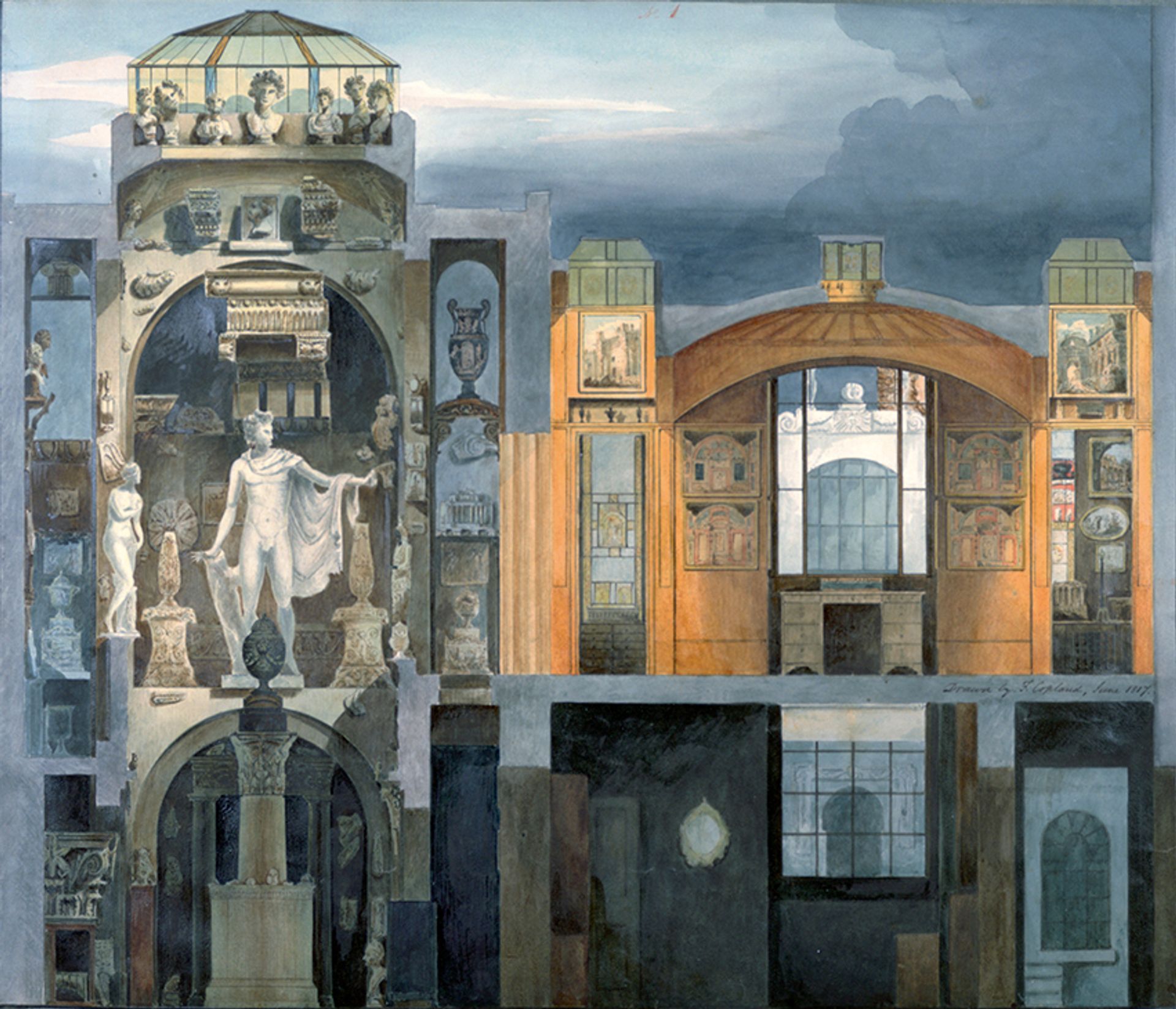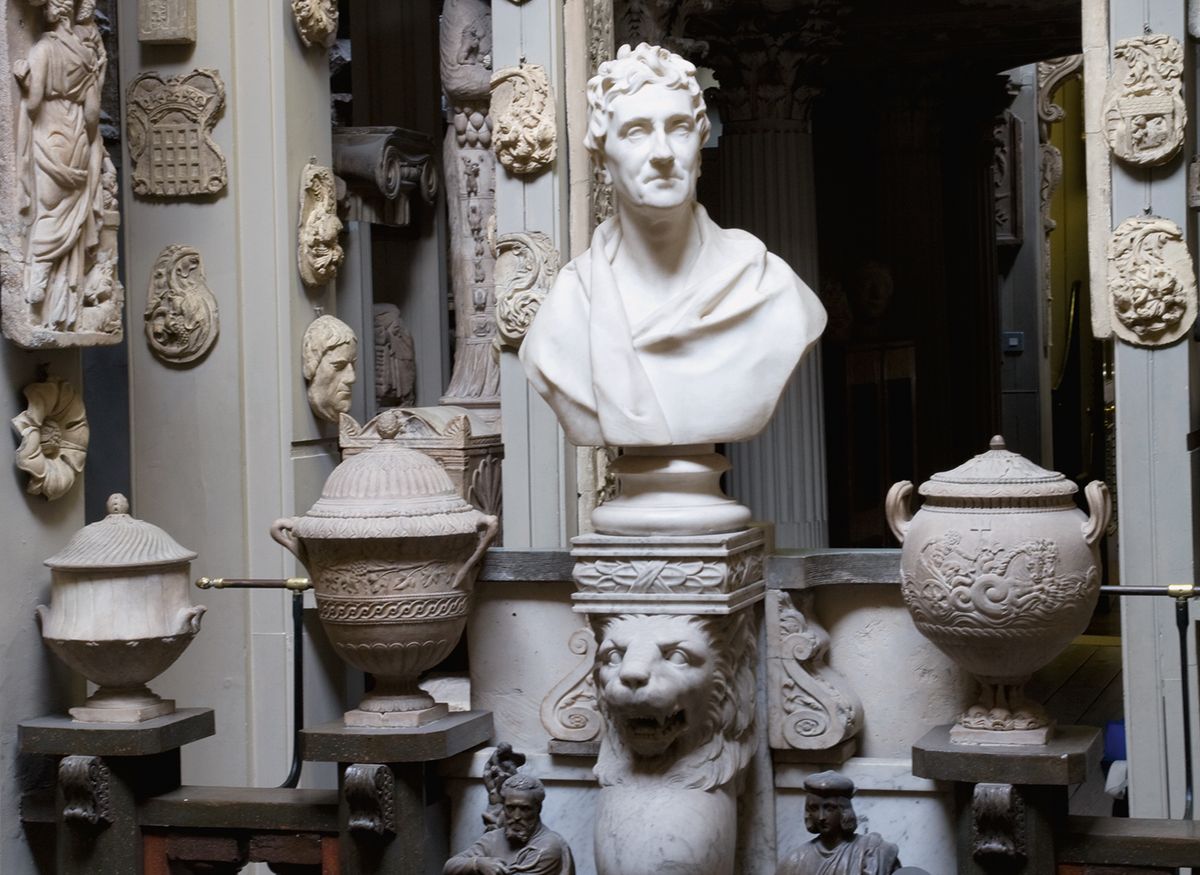In 1812 John Soane—professor of architecture at the Royal Academy of Arts and, arguably, the most original architect in Europe at the time—wrote a fictional account of the fate of his central London terraced house on Lincoln’s Inn Fields, prompted by threats from the local district surveyor against him refacing the street frontage with a projecting loggia. In Soane’s story, set in the distant future, visitors to its ruins wonder if this was the home of a magician or necromancer; a classical statue is mistaken for the owner, turned into marble for using “the power of his diabolic art”. Soane was certainly a conjuror—of space, light and objects—as have been his successors, the curator-directors since his death in 1837. The 14th is Bruce Boucher, who has marked his recent retirement by conjuring up a book about Soane as a collector. Somehow, he makes sense of it all while capturing the special magic of Soane’s museum.
This is not a catalogue of the collection. For the 30,000 architectural drawings and 3,000 inventoried objects, from the Egyptian sarcophagus to mummified cats, a good place to start is the excellent online database. The book’s preface promises to examine the “collection and its setting as a group of objects and interiors on the cusp between the Renaissance cabinet of curiosities and the post-Enlightenment Museum” while “unlocking some of the mysteries around the biggest curiosity in the museum: namely John Soane himself”.
Rather than a chronological biography of Soane as a collector, the book is structured thematically by focusing on specific rooms and types of objects. The prologue explores the origins of the collection and house-museum in Soane’s restless character, which ranged from self-made head of profession and over-ambitious father to temperamental eccentric and paranoid melancholic. Thematic chapters then lead us through Etruscan vases in the Dining Room, on to oil paintings in the Picture Rooms, down to Gothic fragments and casts in the Monk’s Parlour, then to architectural models and scale models of ruins and buildings in the Model Room. Shakespeare and Hogarth are celebrated in Soane’s home as a “Temple of British Worthies”. Masterpieces of contemporary sculpture by Neo-Classicists such as Soane’s close friend Thomas Banks are arranged in the Tivoli Recess and at every opportunity elsewhere.

Frank Copland’s 1817 sectional perspective ofthe dome area and breakfast room in John Soane’s townhouse in Lincoln’s Inn Fields Museum, London Photo: Geremy Butler; © Sir John Soane’s Museum, London
Throughout this collection-focused structure Boucher identifies Soane’s many and successive overlapping aims, not only as a collector but also as a creative curator of changing displays, marrying collections with architectural space as an interior designer in love with picturesque effects and illusions and as a founder of a new kind of private-public museum with multiple roles. As director since 2016, Boucher brings to this challenge an expertise that is exceptional, even among the distinguished holders of the position since Soane himself. Like most of his predecessors he is an architectural historian and inspiring teacher (University College London), but he has also worked as a collecting curator of European sculpture (Art Institute of Chicago) and as a museum director (University of Virginia Art Museum)—roles that inform the perspectives he brings to his analysis.
Ealing to Lincoln’s Inn Fields
The collection first took shape at Soane’s former family home, Pitzhanger Manor in Ealing, and, following its recent restoration, it is now easier to imagine the collection there, in the seat of the Soane dynasty of architects: a succession that never succeeded. The son and brother of bricklayers, Soane had risen through working in the offices of George Dance the Younger and Henry Holland, through studying and shining at the Royal Academy schools and (unlike his friend J.M.W. Turner, the son of a barber) through marrying Elizabeth “Eliza” Smith, an heiress. Collecting, especially of objects from well-known collectors, helped Soane to cover his roots as a rising academician and gentleman. Once it became clear that the disappointing sons (John and George) had no appetite for a family business, the Ealing villa was sold and the study collection of architectural casts, fragments and art had to be crammed into the terraced Lincoln’s Inn Fields townhouse. After his wife’s death in 1815, Soane arranged the collection for his assistants and the students from his Royal Academy lectures, to help foster the British school of architecture and art. The idea of creating a more public museum coincided with the opening of the National Gallery in John Julius Angerstein’s house in Pall Mall in 1824. Soane’s architectural models and designs, contemporary British paintings and sculpture could be seen as a combined Tate Britain, National Portrait Gallery and Victoria and Albert Museum of its day, as well as a museum about himself.
Fortunately for us, Soane could not stop playing with his toys. His concept of his collection evolved from an architect’s open archive into a series of experimental installations that amount to a manifesto of his belief in the union of the sister arts of architecture, painting and sculpture. His collages of visual ideas—“studies for my own mind”, as he wrote—formed “a succession of those fanciful effects which constitute the poetry of Architecture”. Boucher goes one step further than previous attempts to sum it all up by comparing Soane’s thematic installations to the cross-cultural pictorial encyclopaedia assembled by Aby Warburg as his “memory atlas” (Bilderatlas Mnemosyne) in Hamburg, from 1927-29.
The final chapter, the epilogue, summarises the contributions of Soane’s successors. It reveals just how much changed and has been restored, despite the founder’s explicit instructions to his trustees not to “suffer the arrangement…to be altered” in an 1833 act of Parliament. Only the most distinguished of the curator-directors is illustrated: John Summerson. Slim and silver haired, relaxed in his Savile Row suit and gentlemen’s club tie, in a carefully composed photograph taken in 1984 to mark his retirement (at 80), Summerson is urbane as Soane never was, with no chips on shoulders from carrying a brickie’s hod as a boy. After Summerson, Peter Thornton arrived from the Victoria and Albert Museum and launched the brilliant campaign of restoration with Julian Harrap Architects and the “inspectress” (deputy director) Helen Dorey that we all admire today.
Now that the restoration is complete (but for the return some day of furniture and other items such as Soane’s false teeth, deaccessioned long ago) and the house made more accessible (through expansions into next door), what is there left to do? With Will Gompertz as director, we look forward to a new chapter in the great tradition of exhibitions established by the curator Margaret Richardson that Boucher crowned with five-star shows such as Hogarth: Place and Progress (2019). Perhaps the time has come, in post-Brexit Britain, for the exhibitions to offer a more European perspective on Soane as an architect and collector. Meanwhile, this sumptuously illustrated study invites us to see his collection afresh, through the eyes of Soane the eternal conjuror.
• Bruce Boucher, John Soane’s Cabinet of Curiosities, Yale University Press, 224pp, 156 colour & b/w illustrations, £35 (hb), published 11 June
• Julius Bryant is keeper emeritus of the Victoria and Albert Museum and author of Enriching the V&A: A Collection of Collections (1862-1914) (V&A and Lund Humphries, 2022)


